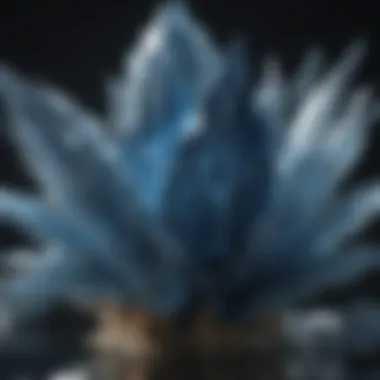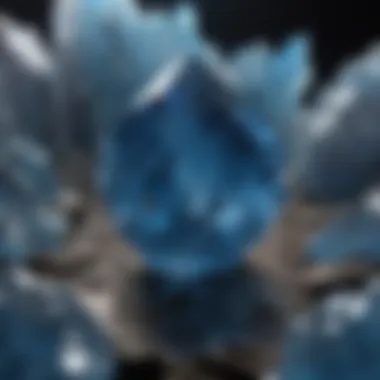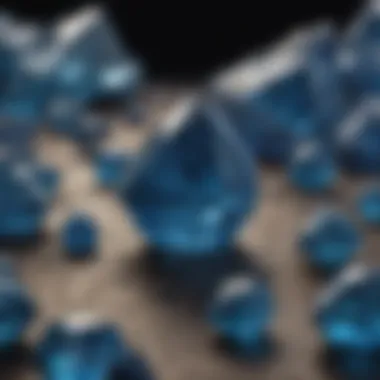Unlocking the Beauty: A Comprehensive Guide to Blue Crystal Identification for Avid Collectors


Rock and Fossil Identification
For avid collectors and enthusiasts seeking to expand their knowledge of blue crystals, understanding rock and fossil identification is crucial. Delving into the vast world of blue crystals involves recognizing various types of rocks and fossils that may house these geological treasures. From igneous to sedimentary rocks, each type presents distinct characteristics that offer clues to the presence of sought-after blue crystals. By honing the ability to identify key attributes such as color, texture, and crystal structure, collectors can effectively distinguish blue crystals from other minerals. Utilizing tools like hand lenses and UV lights enhances the identification process, enabling enthusiasts to pinpoint unique features that define blue crystals.
Collecting Tips and Techniques
Efficiently gathering blue crystals requires adept collecting tips and techniques. Aiming for success in collecting endeavors, enthusiasts should adopt best practices to ensure the preservation and quality of specimens. Identifying prime collecting sites known for abundant blue crystals increases the chances of discovering rare and beautiful specimens. Additionally, safely extracting crystals without causing damage demands precision and care. Implementing techniques such as using digging tools and protective gear aids in preserving both the crystals and the surrounding environment.
Preservation and Display
Ensuring the longevity and allure of collected blue crystals involves mastering preservation and display techniques. Preserving crystals entails employing methods that maintain their natural integrity and beauty. Safeguarding against environmental factors and degradation is vital in sustaining the value of blue crystals. Proper storage methods, such as utilizing airtight containers and protective padding, safeguard crystals from physical damage and oxidation. Displaying blue crystals creatively enhances their aesthetic appeal, with options ranging from bespoke stands to illuminated showcases that showcase their radiance and uniqueness.
Geological Insights
Delving deeper into blue crystals unveils fascinating geological insights that deepen collectors' appreciation for these exquisite treasures. Exploring the geological formations and processes that birth blue crystals sheds light on their origin and formation. Understanding the historical significance of blue crystals and their role in ancient cultures adds a cultural dimension to their allure. Discovering notable blue crystal specimens unearthed by renowned collectors and researchers provides a glimpse into the rich history and discoveries in the field of mineralogy.
Introduction to Blue Crystals
Blue crystals hold a fascination for avid collectors and enthusiasts alike, offering a glimpse into the mesmerizing world of geological treasures. This article serves as a comprehensive guide to understanding and identifying these unique gemstones. By diving into the characteristics, historical significance, and properties of blue crystals, readers can enhance their appreciation and knowledge of these coveted specimens.
Understanding Blue Crystals
Definition of Blue Crystals
Blue crystals, characterized by their striking blue hue, are a captivating subset within the vast realm of gemstones. Their distinct coloration often stems from the presence of specific minerals or impurities in their composition, resulting in a range of shades from deep indigo to serene turquoise. The beauty of blue crystals lies not only in their appearance but also in the energy and calming properties they are believed to possess, making them a popular choice among collectors seeking both aesthetic appeal and spiritual resonance.
Significance in Geology
Blue crystals play a crucial role in geology, offering valuable insights into the Earth's mineral compositions and geological processes. These gemstones are not only aesthetically pleasing but also serve as indicators of the environment in which they formed, providing geologists with essential clues about past geological activities. Their presence in specific rock formations can help geologists map out the history of an area, shedding light on the forces that have shaped our planet over millions of years.
Properties of Blue Crystals
Color Variations


The color variations exhibited by blue crystals are a testament to their diversity and allure. From deep, midnight blues to shimmering cerulean tones, each variation carries its own unique charm and significance. Collectors are drawn to the vivid spectrum of blue hues found in different crystals, with each shade reflecting a distinct mineral composition or formation process. Understanding these color variations not only adds to the aesthetic appeal of blue crystals but also provides insight into their geological origins and properties.
Texture and Formation
The texture and formation of blue crystals are equally intriguing aspects that appeal to collectors and researchers alike. The intricate patterns, growth structures, and crystal formations found in blue crystals offer a glimpse into the dynamic processes that gave rise to these captivating gemstones. Whether formed through volcanic activity, metamorphic processes, or sedimentary deposits, the unique textures and formations of blue crystals hold valuable information about the conditions under which they were created, enriching their geological and aesthetic value.
Historical Significance
Ancient Uses
Throughout history, blue crystals have held a prominent place in various cultures and civilizations, revered for their beauty, rarity, and metaphysical properties. Ancient civilizations used blue crystals for decorative purposes, jewelry, and even as talismans for protection and healing. The significance of blue crystals in ancient rites and ceremonies underscores their enduring appeal and symbolic importance across different timelines and cultures.
Symbolism
Blue crystals carry rich symbolism across different belief systems and traditions, often representing qualities such as serenity, wisdom, and spiritual enlightenment. In various mystical practices and spiritual traditions, blue crystals are associated with communication, intuition, and mental clarity. Their calming energy and vibrational frequencies are believed to balance the mind, body, and spirit, making them valuable tools for meditation, healing, and personal growth.
Identifying Blue Crystals
The section on identifying blue crystals is pivotal in this comprehensive guide, offering insight into the unique characteristics that make each crystal distinct. For avid collectors and enthusiasts, understanding the specifics of blue crystals is essential for identifying authentic specimens and broadening their collection. By focusing on key elements such as physical characteristics, optical properties, and hardness tests, collectors can deepen their appreciation and knowledge of blue crystals.
Physical Characteristics
Color Intensity
Color intensity plays a crucial role in identifying blue crystals, as it distinguishes various shades and hues within a crystal. The depth and richness of color can indicate the presence of certain minerals or elements, offering clues to the crystal's formation and rarity. Collectors often seek out blue crystals with intense and vibrant colors, as they are highly prized for their visual appeal and uniqueness. However, variations in color intensity can also impact the overall value and desirability of a crystal, making it a significant factor to consider when identifying blue crystals.
Transparency
Transparency refers to the clarity and translucency of a crystal, which can range from opaque to transparent. In blue crystals, transparency plays a vital role in determining the crystal's quality and purity. Crystals with high transparency are coveted for their brilliance and ability to showcase internal structures and inclusions. However, the level of transparency can also influence the crystal's value, with fully transparent crystals often being more sought after by collectors.
Crystal Structure
The crystal structure of blue crystals is a defining feature that sets each specimen apart. It refers to the geometric arrangement of atoms and molecules within the crystal lattice, which determines the crystal's physical properties and overall appearance. Different crystal structures result in varied textures, cleavage patterns, and growth formations, making them essential considerations in crystal identification. Understanding the crystal structure not only helps collectors classify and categorize blue crystals but also provides insights into their formation processes and geological significance.


Popular Blue Crystals
Blue Crystal Varieties
Azurite
Azurite, with its deep azure hue and rich history, stands out as one of the most sought-after blue crystals. Its key characteristic lies in its striking color intensity, which captivates collectors seeking a vibrant addition to their collections. Known for its beneficial metaphysical properties, Azurite is revered for enhancing intuition and insight, making it a popular choice among crystal enthusiasts. Its unique feature of promoting spiritual growth and inner wisdom adds a profound dimension to this crystal, although its tendency to absorb negativity might be a consideration for some collectors.
Sodalite
Sodalite, recognized for its serene blue tones and elegant veining, enriches the world of blue crystals with its calming presence. A key characteristic of Sodalite is its harmonizing properties, making it an ideal choice for those seeking balance and peace in their crystal collections. Its unique feature lies in its ability to stimulate rational thought and enhance communication skills, presenting a beneficial addition to this comprehensive guide. However, Sodalite's potential for heightening sensitivity to emotions may be a factor for collectors to consider.
Blue Lace Agate
Blue Lace Agate, with its delicate bands of light blue and white, exudes a sense of tranquility and grace. The key characteristic of Blue Lace Agate is its soothing energy, which invites a sense of calm and relaxation to collectors' spaces. Chosen for its popularity in promoting inner stability and clarity, Blue Lace Agate offers a gentle touch to any crystal collection. Its unique feature of harmonizing mind, body, and spirit adds an enriching aspect to this article; however, its susceptibility to damage from physical impact may require careful handling from collectors.
Origin and Occurrence
Geographical Sources
Geographical sources play a significant role in understanding the distribution and availability of blue crystals in nature. Highlighting key characteristics of geographical sources helps enthusiasts appreciate the geological diversity of blue crystal formations. Considering the unique features of each location enriches this guide with valuable insights for collectors, although variations in accessibility and quality may impact certain specimens.
Formation Process
The formation process offers a glimpse into the intricate journey of how blue crystals are created in nature. Understanding the key characteristics of the formation process sheds light on the geological conditions necessary for the development of these captivating minerals. Exploring the unique features of each formation process provides collectors with a deeper understanding of the origins of their beloved blue crystals, although variations in formation timelines and complexities may influence their appeal.
Caring for Blue Crystals
Blue crystals require proper care to maintain their beauty and value. Caring for blue crystals is a crucial aspect for avid collectors to ensure their longevity and preservation. By understanding the significance of proper maintenance, collectors can protect their prized specimens from damage and deterioration. This section delves deep into maintenance tips and precautions related to cleaning and storage of blue crystals.
Maintenance Tips
Cleaning


Cleaning blue crystals is essential to eliminate dirt, dust, and residue that can dull their brilliance. A gentle approach is key, using mild soap and water to gently cleanse the crystals without causing damage. Avoid harsh chemicals or abrasive materials that may scratch or corrode the crystal surface. Regular cleaning not only enhances the crystal's appearance but also prevents the buildup of grime that can affect its overall aesthetic.
Storage
Proper storage is paramount to safeguard blue crystals from external factors that may cause harm. Storing crystals in a cool, dry place away from direct sunlight helps maintain their color and luster. Utilizing soft padding or cloth-lined containers prevents crystals from knocking together and risking chipping or surface scratches. Additionally, storing blue crystals separately from other minerals reduces the risk of chemical interactions that could lead to damage over time.
Avoiding Damage
Sensitivity to Light
Blue crystals, like many other gemstones, can be sensitive to prolonged exposure to sunlight or artificial light sources. Certain varieties may fade or change color when exposed to direct light for extended periods. It is advisable to display blue crystals in shaded areas or use UV-protective glass cases to shield them from harmful light rays. By minimizing light exposure, collectors can preserve the vibrancy and integrity of their blue crystals for years to come.
Chemical Exposure
Chemical exposure poses a significant threat to the beauty and structure of blue crystals. Avoid contact with household chemicals, perfumes, or cleaning agents that contain harsh substances like acids or alkalis. These chemicals can react with the crystal composition, leading to discoloration, etching, or surface damage. Prioritize safe handling practices and use protective gloves when cleaning or handling blue crystals to prevent unintended chemical reactions that could mar their pristine condition.
Conclusion
In the realm of blue crystal identification for avid collectors, the conclusion serves as a pivotal segment that consolidates the essence of the entire discourse. This section encapsulates the key takeaways and overarching themes discussed throughout the comprehensive guide. By delving into the significance of the conclusions drawn, readers can deepen their understanding of the subject matter and its implications. From shedding light on the aesthetic value to highlighting the educational importance of blue crystals, the conclusion acts as a culmination of insights that enrich the reader's knowledge and appreciation.
Appreciating Blue Crystals
Aesthetic Value
Aesthetic value in the world of blue crystals plays a crucial role in captivating collectors and enthusiasts alike. The allure of these mesmerizing gems lies in their unique beauty and visual appeal. Each blue crystal encapsulates a distinct charm, from the deep azure hues of azurite to the serene elegance of blue lace agate. The aesthetic value of blue crystals adds an element of artistry to geological wonders, enhancing their desirability among collectors. However, while the aesthetic appeal of blue crystals is undeniable, collectors must also consider factors like authenticity and rarity to truly appreciate the value they bring to their collection.
Educational Importance
Beyond their aesthetic allure, blue crystals hold significant educational value for enthusiasts and collectors. Studying blue crystals provides valuable insights into geological processes, mineral formations, and historical uses. By understanding the composition and properties of blue crystals, enthusiasts can gain a deeper appreciation for the Earth's natural treasures. Furthermore, blue crystals offer a window into the cultural and symbolic significance attached to these gemstones throughout history. The educational importance of blue crystals extends beyond mere admiration, serving as a doorway to exploration and knowledge enrichment for collectors.
Final Thoughts
Continued Exploration
The journey of exploring blue crystals is a never-ending quest for knowledge and discovery. Continued exploration allows collectors to unearth new specimens, expand their understanding of different varieties, and connect with fellow enthusiasts. Delving deeper into the world of blue crystals opens the door to new possibilities, from uncovering rare specimens to researching novel formations. The spirit of continued exploration fuels the passion of collectors, driving them to seek out new experiences and connections within the captivating realm of blue crystals.
Collecting Ethically
Ethical collecting practices are paramount in preserving the integrity and sustainability of blue crystal specimens. Collecting ethically involves respecting existing laws and guidelines, obtaining specimens through legal channels, and minimizing environmental impact. By prioritizing ethical collecting practices, enthusiasts can contribute to the conservation of natural resources and protect fragile ecosystems. Embracing ethical standards in collecting not only upholds the reputation of collectors but also ensures a bright future for blue crystal enthusiasts and the preservation of these geological wonders.







